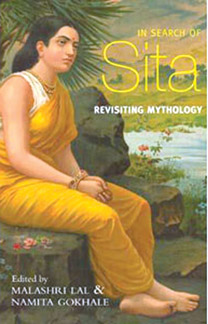Daughters of mother earth

Sita has been in the mass consciousness of the subcontinent from the
beginning of timeless history. This is probably why Namita Gokhale, on a
visit to Sri Lanka thought she saw Sita sitting on a rock in the
Peradeniya Gardens, which set her on a path to search for Sita.
“In Search of Sita. Revisiting Mythology”, Edited by Prof. Malashri
Lal and Namita Gokhale. was the outcome, giving us an opportunity to
learn about the true Sita.
Malashri Lal and Gokhale, take us on a long journey from Pre Vedic
India, through the invasions by the so-called Aryans, Muslims and the
British to post colonial India introducing Sita in all her different
forms, from all the different versions of the Ramayana.
The book is a collection of essays, conversations and commentaries,
followed by Creative Interpretations about Sita. I would not say it is
about Rama and Sita. Sita has always been misunderstood, her role
misinterpreted and almost always misrepresented by the Ramayana writers
who were mostly males. ‘In Search of Sita’ mentions only one female
writer, the Bengali poet Chandravati. The creators of every Ramayana
version always had their own reasons to talk mostly about Rama. In
Valmiki Ramayana, Sita appears only in 76 sargs out of 645!
Rama is called “maryada purushottam” the ideal person, epitomizing
the highest discipline expected of a human being, like in
Ramacharitamanas of Tulsidas. But was he an ideal husband in most of the
Ramayana versions? A man who challenges his loving wife to jump into a
pyre to prove her chasteness and then banishes her when she is pregnant
with his own progeny. It is also argued that this incident was never in
the original Valmiki. Was he an ideal man because he had the courage to
cut off the nose of Surpanakha, just because she desired him?
 Sita has been an ideal wife in almost all versions. However, in this
book I could not find an ancient Indian word for an ideal woman. Sita has been an ideal wife in almost all versions. However, in this
book I could not find an ancient Indian word for an ideal woman.
The book is full of information, from the many versions of the
Ramayana, said to be over 400, in so many different languages, dialects
and religious faiths. The ‘original Valmiki’ Adi-Ramayana had developed
into three regional versions. There are over 50 versions written in
Oriya, the most famous is Jagamohan Ramayana by Balarama Das, which
shows Sita as the glorious victim and the triumphant woman.
Some versions try to preserve the purushottam image by saying that
Rama himself created an image of Sita and it was this image that was
abducted by Rama. There are the versions of how Sita was trapped with a
painting of Ravana to create doubt in Rama’s mind. This is found in one
of the Bengali versions of Chandravati and in the Jain work of
Haribhadra Suri.
There is R.K. Narayana’s more romantic version of the Ramayana based
on Kamban’s 12th century Ramavataram. The 16th century Ananda Ramayana
also paints a romantic picture.
Gandhi had highlighted Sita’s self-sacrifice and infinite capacity
for suffering, and his methods of non-violence developed due to the
influence of women. Nehru had preferred to look up to Chitrangada, the
Manipuri princess immortalized by Tagore. Nehru had recognized women’s
need to grow and emancipate themselves. Nehru had regarded India as a
feminine country. But still most Indian women suffer behind the Lakshman
Rekha.
Sita has been considered as Kali when she destroyed thousand headed
Ravana, and again as Gauri the faithful wife of Rama. Kali, naked and
fearsome, is the Earth in her wilderness. Gauri, clothed and gentle, is
the domesticated Earth.
Malashri Lal refers to the Earth Goddess Sita mentioned in the Rig
Veda, which predates Valmiki.
Rama is believed to be the only Indian God who was faithful to one
wife, but also the only Deity to have abandoned his wife! In the Indian
culture it is the mother who is sacred, and most Ramayana versions did
not allow Sita to attain motherhood, for 16 years of marriage and she
conceives only before her banishment.
In Mahasuvi Ramayan, Ravana and Mandodari has a daughter. As it was
predicted that the daughter would cause Ravana’s death, she was placed
in a casket, which ended up in the fields of the king Janaka. That is
how Sita was not touched by Ravana, because subconsciously he did not
desire her.
The sage Valmiki was watching a pair of karuncha birds (Sarus crane -
Grus antigone), when a hunter had shot and killed the male bird.
Listening to the female bird’s lament had made a poet out of a sage.
Thus Valmiki became the first poet of Sanskrit literature.
1987 Ramanand Sagar produced the TV serial Ramayana, commercializing
the epic using all the latest electronic technology available. Much
later Ekta Kapoor introduced a new version of Sita in the character of
Tulsi Virani in the production Kiunki Saas Bhi Kabhi Bahu Thi.
(mahagedara to Sri Lankan viewers).
Earlier Deepa Mehta in his film “Fire” had been forced to change the
name from Sita to Nita due to the anger of the public, for trying to
defile a sacred name. In literature Anita Desai has a conventional Sita
in ‘Where Shall we go This Summer’.
Rashna Imhasly-Gandhy, the Jungian psychotherapist, says “The
Ramayana is the exponent of rigid brahmanical standards of male-female
relationships...a confrontation between non-Aryan and Aryan
cultures...an encounter between the patrifocal social systems and
matrifocal ones”
As Tarun Vijay, ends his essay, “The truth remains that Sita, who was
also Janaki, Vaidehi, Bhudevi, Maithily and, in fact, the quintessential
spirit of our land and minds, was the greatest inspirational icon in our
lives in India, and remains so, without there being any necessity to
‘modernize’ her.”
[email protected]
|



